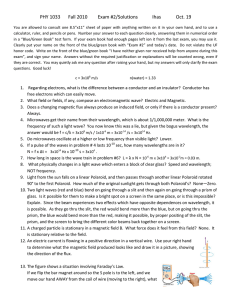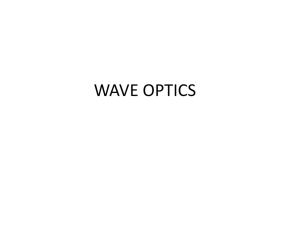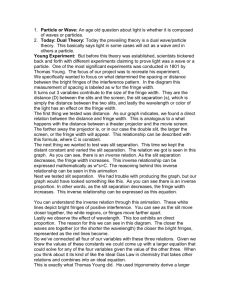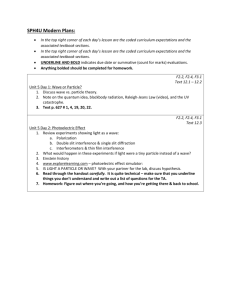Shedding Light on Wave-Particle Duality
advertisement
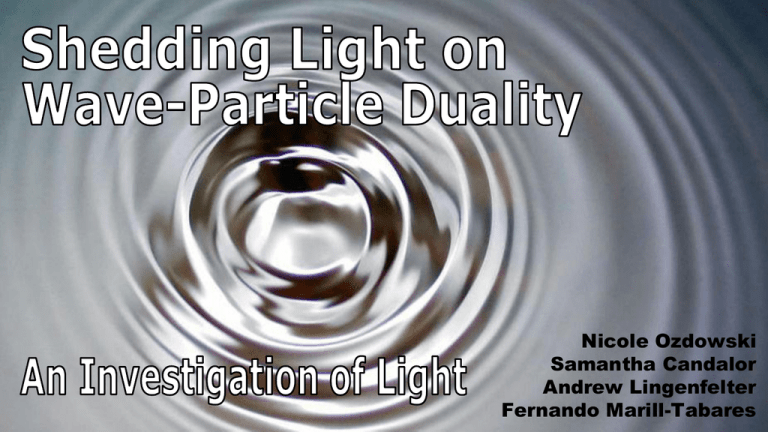
Nicole Ozdowski Samantha Candalor Andrew Lingenfelter Fernando Marill-Tabares Wave Theory of Light Aristotle (384–322 BC) [4th century BC] Pythagoras (570-495 BC) [6th century BC] 17th Century: Christiaan Huygens (1629-1695) Isaac Newton (1642-1727) 19th Century: Thomas Young (1773-1829) Augustin Fresnel (1788-1827) 1861: James Clerk Maxwell (1831-1879) ● Proved that Electricity and Magnetism were expressions of the same thing. ● Found the equality between an electromagnetic wave and light Einstein’s Photoelectric Effect Heinrich Hertz (1857-1894) Albert Einstein (1879-1955) Quantum Mechanics: Wave-Particle Duality Interference Constructive Interference Destructive Interference Young’s Double Slit Experiment Δx = λD/a Δxr = 0.47cm Δxg = 0.40cm Setting Up the Experiment Light Sensor and Single Slit Laser and Double Slit Results Δxr,th = 0.47cm Δxr,exp = 0.467cm %error = 0.64% Δxg,th = 0.40cm Δxg,exp = 0.413cm %error = 3.25% Conclusion: Light acts as a wave. The Photoelectric Experiment The Concept Setting Up the Experiment Mercury Lamp and Detector Meters Amplifier and Results ● V=(h/e)*f ● Slope is equal to h/e ● h/e = -4.136*10-15 Js/C ● Our slope = -2.317*1015Js/C The closeness of the two values confirms the photoelectric effect. Conclusion: Light acts as a particle. Single Photon Detection Double Slit Experiment ● Repeat the double slit experiment ● Count photons instead of measuring intensity ● If light is a wave then detector won’t count ● If light is a particle, there won’t be an interference pattern. Experimental Setup Laser and Double Slit tube Photomultiplier Results Theoretical ΔX: 0.2626 cm Experimental ΔX: 0.2622 cm Error: 0.15% Counts of Single Photons produce an Interference Pattern. Conclusion: Light acts as a wave and a particle. Conclusion Is light a wave? The double slit experiment says yes. Is light a particle? The photoelectric experiment says yes. Is light both? The photon detection experiment says yes. Therefore… Light is a Wavicle. Quantum Mechanics: Wave-Particle Duality Light as a Wave: Light as a Particle: ● Well defined momentum and wavelength ● Well defined position ● Position is spread out and unclear ● Wavelength is unclear ● Can interfere and diffract as a wave would ● Can slam into particles Acknowledgments Dr. Luokkala - PGSS Director Patrick Diggins and Zach McDargh - Project Leaders Patty Yoritomo - Project TA Corporate and Private Sponsors PGSS Alumni Association PGSS Campaign References http://en.wikipedia.org/wiki/Thomas_Young_(scientist)#mediaviewer/File:Thomas_Young_(scientist).jpg http://www.physicsoftheuniverse.com/images/quantum_double_slit.jpg http://i.stack.imgur.com/Q4brH.gif http://upload.wikimedia.org/wikipedia/commons/3/39/GodfreyKneller-IsaacNewton-1689.jpg http://images.gizmag.com/hero/so-you-think-youre-confused-about-quantum-mechanics-9.jpg http://www.scenicreflections.com/files/Marble_columns_Wallpaper_f3cq8.jpg http://evlocker.files.wordpress.com/2012/10/2012-02-18.jpg http://www.marius-riether.com/wp-content/uploads/2013/05/Particles1.jpg http://www.quantumdiaries.org/wp-content/uploads/2011/07/feynman_qqGamee1.png https://wiki.brown.edu/confluence/download/attachments/72637259/image003.Png http://abyss.uoregon.edu/~js/21st_century_science/lectures/lec13.html http://hdw.eweb4.com/wallpapers/8080/ http://www.faqs.org/docs/qp/chap03.html http://en.wikipedia.org/wiki/Heinrich_Hertz
